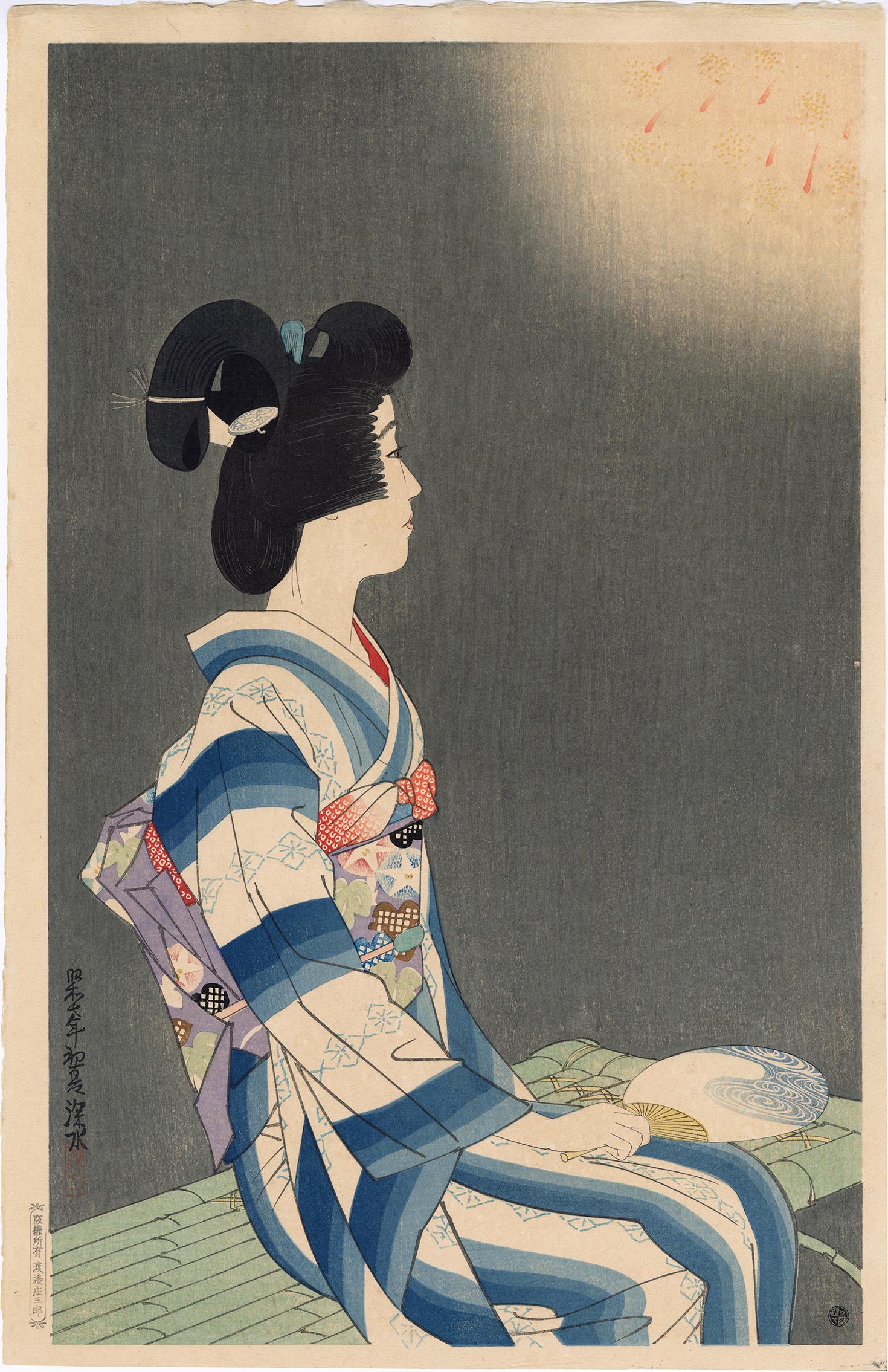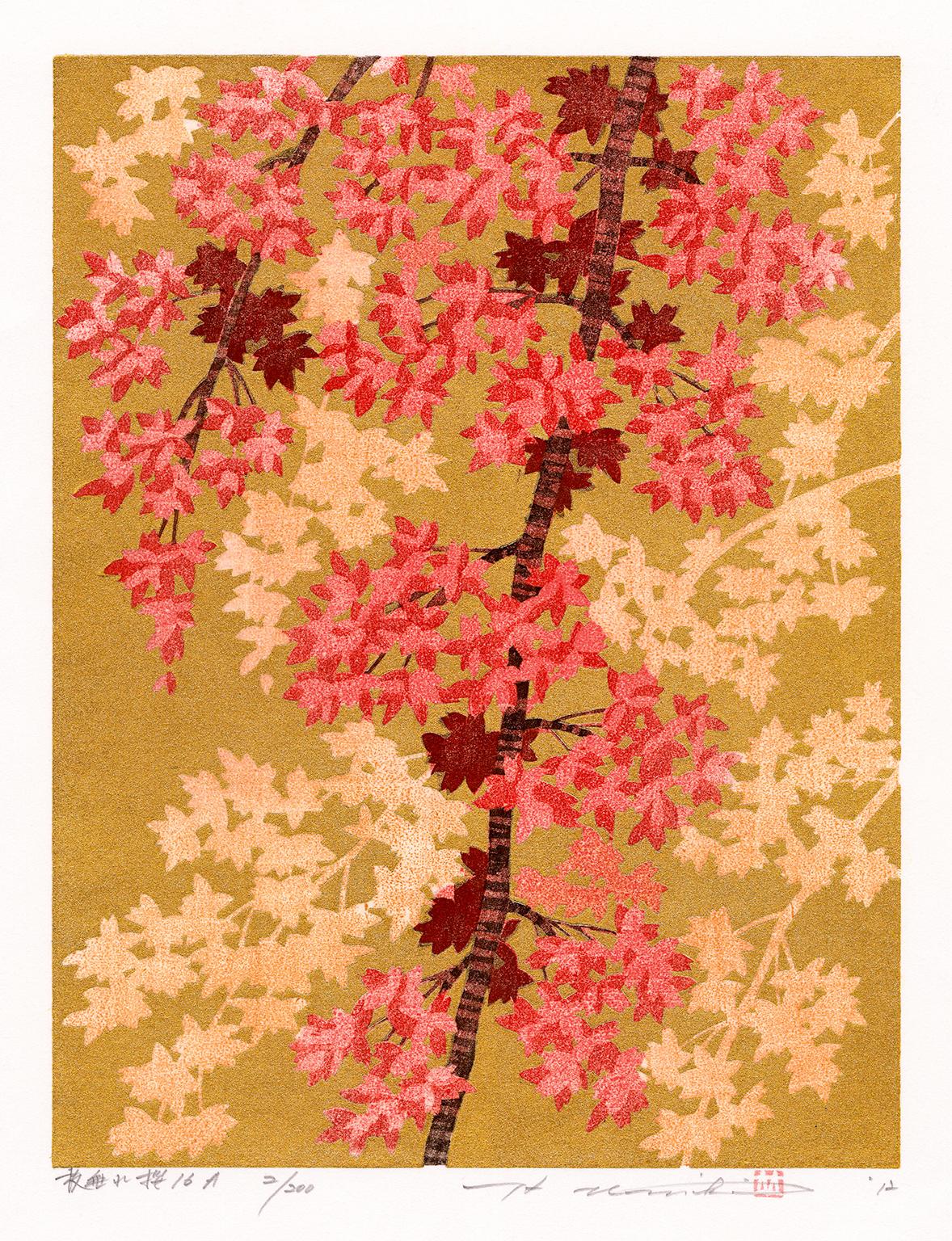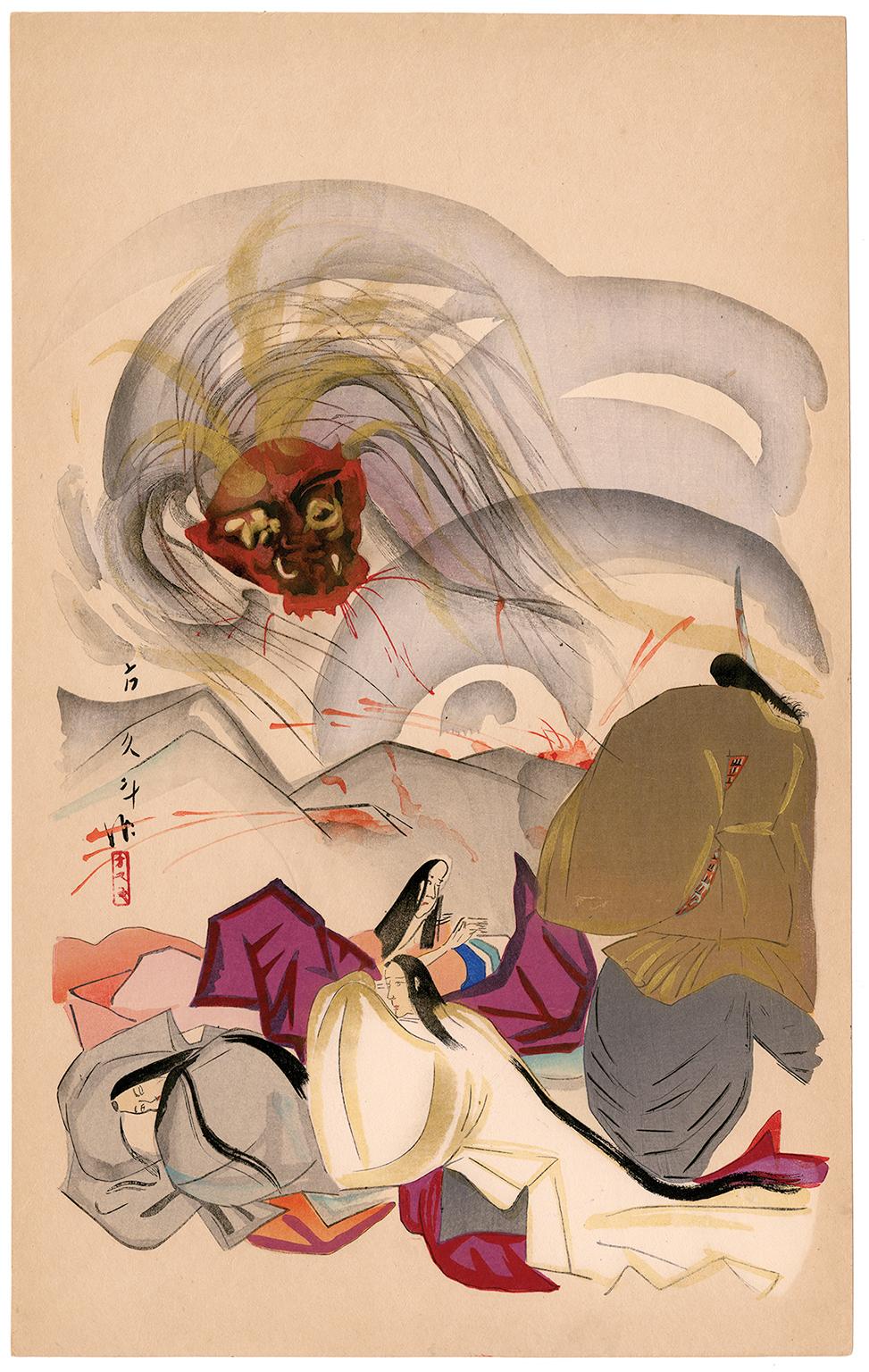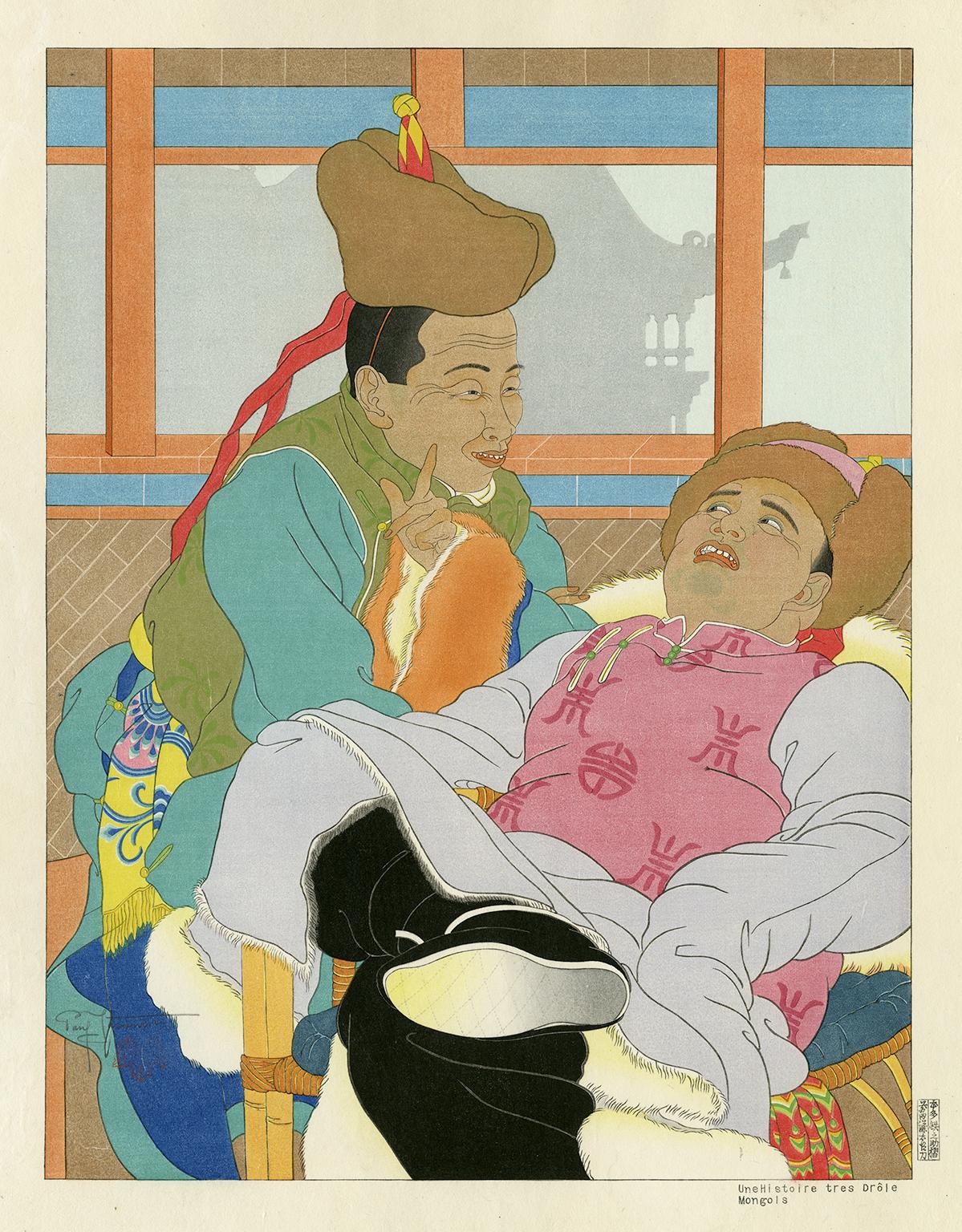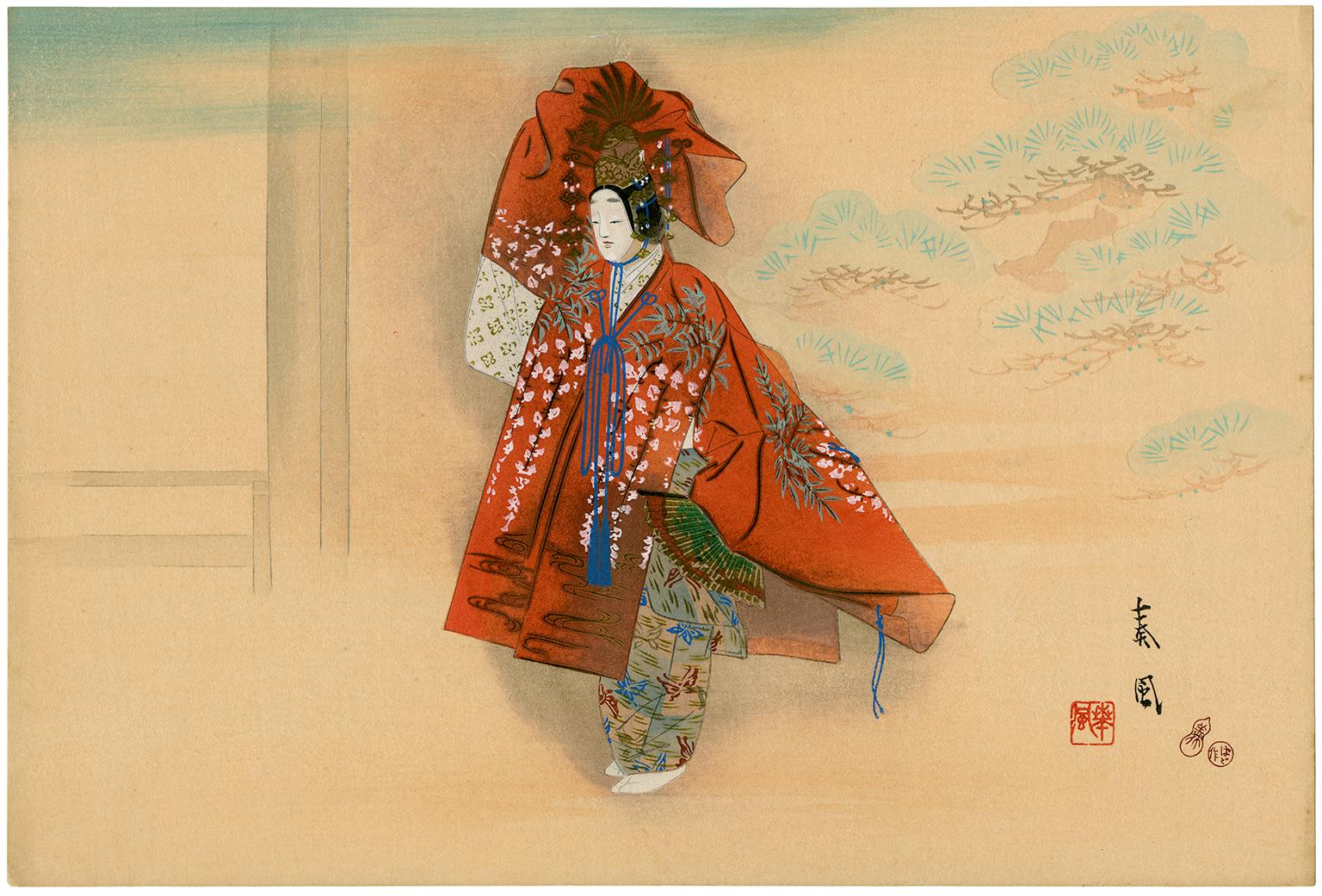Items Similar to Thirsty: The Appearance of a Town Geisha - a So-Called Wine-Server - in the Anse
Want more images or videos?
Request additional images or videos from the seller
1 of 7
Taiso YoshitoshiThirsty: The Appearance of a Town Geisha - a So-Called Wine-Server - in the Anse1888
1888
About the Item
Thirsty: The Appearance of a Town Geisha - a So-Called Wine-Server - in the Ansei Era
Color woodcut, 1888
Signed; Seal: Taiso (see photo)
Plate 22 from the series "Thirty-two Aspects of Customs and Manners" (Fuzoku Sanjuniso)
Format: Oban
Publisher: Tsunashima Kamekichi
Carver: Hori Yu
A first edition with tricolor cartouche, and black lacquer highlights
Yoshitoshi's "Thirty-two Aspects" depicts women of different social classes during the previous 100 years. The Ansei Era was 1854-1860.
Condition: Excellent
Image/Sheet size: 14 1/8 x 9 5/8 inches
Reference: Beauty and Violence 63.22
Stevenson, Yoshitoshi's Women, No. 22, pp. 72-73, reproduced in color
TAISO YOSHITOSHI
(1839-1892)
Taiso Yoshitoshi was born in the city of Edo (now Tokyo) just before Japan’s violent transformation from a medieval to a modern society. In the mid 19th century pressures from the United States and Europe brought an end to Japan’s two hundred years of self-imposed isolation. In 1868 a pivotal period began known as the Meiji Restoration. It was marked by the return of Imperial power, heightened militarism, a new constitution and industrial advancement, as well as social and political reform. In the midst of shifting values, woodblock print artists like Yoshitoshi struggled to create images that would satisfy the public’s changing tastes.
During the Edo period (1600-1868) woodblock prints, or Ukiyo-e (literally “pictures of the floating world”), became one of the most popular and inexpensive visual art forms in Japan. Published in the cities, visitors bought them as souvenirs and gifts from markets and street peddlers and returned with them to remote villages. From the time the first monochrome prints were published in the 1600s, Ukiyo-e represented a unique collaboration between the publisher, the artists and the public. The rising or diminishing interests of the urban merchant class largely dictated the choice of subject matter in woodblock prints.
Yoshitoshi’s confrontation with the savagery and violence of his times, especially early on in his career, was exorcised through a prolific and bloody series of prints depicting battling warriors, demons and murderers. Later in his career, however, Yoshitoshi’s work took on a distinctive stylistic change. By the 1880s, he was experimenting freely with western concepts of space, perspective and dissonant color combinations. His treatment of movement and facial features reflected a more studied and quiet observation of the human form and emotions. While continuing to choose native themes for his prints, Yoshitoshi’s approach to creating individualized portraits of townspeople, farmers, courtesans and warriors was innovative and groundbreaking. However, by the end of the Meiji Period (1868-1912), the increasing popularity of photography and lithography nearly eclipsed the public’s interest in woodblock prints. Yoshitoshi stood alone as the last great master of Ukiyo-e.
Biography courtesy International Folk Art
- Creator:Taiso Yoshitoshi (1839-1892, Japanese)
- Creation Year:1888
- Dimensions:Height: 14.13 in (35.9 cm)Width: 9.63 in (24.47 cm)
- Medium:
- Movement & Style:
- Period:
- Condition:
- Gallery Location:Fairlawn, OH
- Reference Number:
About the Seller
5.0
Recognized Seller
These prestigious sellers are industry leaders and represent the highest echelon for item quality and design.
Platinum Seller
These expertly vetted sellers are 1stDibs' most experienced sellers and are rated highest by our customers.
Established in 1978
1stDibs seller since 2013
712 sales on 1stDibs
Typical response time: 1 hour
Associations
International Fine Print Dealers Association
- ShippingRetrieving quote...Ships From: Fairlawn, OH
- Return PolicyA return for this item may be initiated within 10 days of delivery.
More From This SellerView All
- Morita Kanya XIII As Genta Kagesue in the play Genta KandoBy Natori ShunsenLocated in Fairlawn, OHMorita Kanya XIII As Genta Kagesue in the play Genta Kando Color woodcut, 1928 Signed and stamped middle right edge Natori stamp lower left image edge Series: Collection of Creative...Category
1920s Showa Figurative Prints
MaterialsWoodcut
- Xylon 21 Naoko Matsubara USALocated in Fairlawn, OHXylon 21 Naoko Matsubara USA Woodcuts, two which are printed in color, 1970 2 of the 5 woodcuts signed in pencil (see photos) Five original woodcuts, two of which are signed in pencil With introduction entitled Honest Pinetree by Frizt Eichenberg The images are: The Quaker’s Meeting, double page woodcut cover on grey/green paper, signed in pencil, with usual centerfold Publisher: Sekton Schweiz de Xylon, Zurich Date: August 1970 Edition: 500 Sylvan Snow, double page woodcut (with usual centerfold), signed in pencil, dedicated and dated, depicting a forest Verso: Dragon, double page woodcut, with usual centerfold, depicting a dragon Indian Dancer, double page woodcut in black and green (with usual centerfold), depicting dancer Verso: Chinese Dancer. woodcut in red, depicting a dancer Condition: Very good, usual handling issues for paper portfolio Centerfolds as issued Signle filio: 19 3/8 x 13 1/2 inches Double folio: 19 3/8 x 27 inches Publisher: Sekton Schweiz de Xylon, Zurich Date: August 1970 Edition: 500 Provenance: Amity Art Foundation, Inc. A rare dedicated example with a dedication in pencil “For Frank” and dated 1970 Note: Matsubara graduated from the Kyoto University of Applied Arts in 1960. She then pursued an MFA in the School of Fine Arts at the Carnegie Mellon University in Pittsburgh on a Fulbright Travel Grant, and since then has traveled extensively and taught at the Pratt Institute in Brooklyn—a rare distinction for a Japanese woman. She also studied one year at the Royal College of Art, London. Currently she lives and works in Oakville, Canada. Naoko Matsubara’s style is influenced by her teacher Munakata Shiko (1903–1975), who worked in the mingei (folk art) tradition. Her works are part of the collections of many museums around the world such as the Philadelphia Museum of Art, the Chicago Art Institute, the Royal Ontario Museum, the Albertina in Vienna, the British Museum in London, the Kyoto National Museum of Modern Art, the Museum of Fine Arts, Boston, the Tokyo National Museum of Modern Art, the Smithsonian Institution and the Library of Congress in Washington, the Hamburg Museum of Arts and Crafts, the Haifa Museum in Israel and the Art Gallery of New South Wales in Sydney. She was made a member of the Royal Canadian Academy of Arts. (Courtesy of Wikipedia) Naoko Matsubara (1937 - ) Matsubara Naoko (松原直子) was born in 1937 on Shikoku Island into an old Shinto family, and grew up in Kyoto, where her father was a senior priest. She was educated at the Kyoto Academy of Fine Art (BFA, 1960); and was a Fulbright Scholar at what is now Carnegie Mellon University, Pittsburgh (MFA, 1962). She was also a Special Invited Student at the Royal College of Art in London (1962). After travelling extensively in Europe and Asia, Naoko Matsubara returned to Japan for two years, before being lured back to the United States. There she worked as personal assistant to the late Prof. Fritz Eichenberg, and also taught at the Pratt Institute of Graphic Art in New York, as well as at the University of Rhode Island. Subsequently she lived in Cambridge, Mass. In 1972 Naoko Matsubara moved to Canada, and now lives in Oakville, Ontario. She has continued to be extremely active as an artist: locally, nationally and internationally. Since 1960 she has had some 75 solo exhibitions, in the USA, Canada, Japan, England, Ireland, Germany, Austria, Switzerland, Holland and Mexico. She has also participated in numerous group exhibitions. Public collections owning work by Naoko Matsubara include: Albertina, Vienna; Art Institute of Chicago; British Museum; Carnegie Institute; Museum für Kunst und Gewerbe, Hamburg; Museum of Fine Arts, Boston; Philadelphia Museum of Art; Cincinnati Art Museum; Detroit Institute of Art; Fogg Art Museum, Harvard University; Haifa Museum, Israel; Kyoto National Museum of Modern Art; Royal Ontario Museum; The White House, Washington DC; Tokyo National Museum of Modern Art; Yale University Art Gallery. Naoko Matsubara has published some 20 books and portfolios of her work, including most recently Tibetan Sky (Calgary: Bayeux Arts Publishers, 1997; Preface by the Dalai Lama); Tokonoma (Bath, England: Old School Press, 1999); and Konjaku monogatari (Tokyo: ALIS, 2002). Her work also includes a large mural and donor pillar for the new YMCA building in Oakville, Ontario (2003); mixed-media screens; and paintings. In 2005, the Royal Ontario Museum commissioned two large works from Naoko Matsubara for the Museum's Bloor Street window case. The artist generously donated a third work, Emerald Summer (2006). The three works (each 195 cm. high by 95 cm. wide) will be rotated at regular intervals into the outside window. This is the first commissioned artwork to be displayed on the Museum’s Bloor Street Plaza. Recent major exhibitions have been in Tokyo, Kyoto, Indiana, and Toronto (Royal Ontario Museum). Further exhibitions are currently being planned in Seattle and Tokyo; new books in process include In Praise of Hands. She also continues to travel widely; is frequently invited to speak about her work; and also publishes essays, in both English and Japanese. Naoko Matsubara’s work has been the subject of countless articles and reviews; documentary films (including two from the Canadian Broadcasting Corporation); and several book-length publications: notably Mokuhan: The Woodcuts of Munakata and Matsubara (text by Joan Stanley-Baker; Victoria, BC: Art Gallery of Greater Victoria, 1976); Naoko Matsubara: Development of Artistic Style and Technique (text by Barbara Woodworth; MFA thesis, Harvard University, 1985);.and Tree Spirit...Category
1970s Abstract Figurative Prints
MaterialsWoodcut
- WO RO SI IA ZIN Russian Soldier with His FamilyLocated in Fairlawn, OHWO RO SI IA ZIN Russian Soldier with His Family Color woodcut, 1861 2nd month Signed upper left (see photo) Titled upper right in black cartouche (see photo) Format: oban Style: Yokohama-e Publisherr: Sagamiya Tokichi (Marks #435) active 1955-1866 Metropolitan Museum of Art in New York, has an impression of this image RARE Condition: with usual aging Image size: 13 7/8 x 9 3/8 inches Rebecca Salter in her Japanese Popular Prints... on page 18 gives a different take on the situation that Yoshifuji found himself in. "A giant of the period, however, was Utagawa Kuniyoshi (1797-861). Although best known for warrior prints which reflected the militaristic undercurrents of the time, he was also responsible for some of the most light-heartend and humorous works in this book. His followers in the Utagawa school, Utagawa Yoshitsuya...Category
1860s Other Art Style Figurative Prints
MaterialsWoodcut
- Beauty on a Veranda with Fan and MirrorBy Suzuki (Hozumi) HarunobuLocated in Fairlawn, OHSigned: Harunobu ga Series: Series: Eight Fashionable Parlor Views (Furyu zashiki hakkei)? Format Japanese: chuban Provenance: Private Collection, Philadelphia Collection of McCleaf ...Category
Mid-18th Century Edo Prints and Multiples
MaterialsWoodcut
- Les Amateurs d'EstampesBy Félix VallottonLocated in Fairlawn, OHLes Amateurs d'Estampes Woodcut, 1892 Initialed in the plate lower left Titled below image: "Gravure originale sur bois par F. Vallotton" Reference: Valloton and Goerg 107c, with the purple address stamp upper right center (see photo) Condition: Excellent Aging to sheet One spot of printers ink outside of the image in the upper margin Block size: 7 3/8 x 10 inches Sheet size: 10 1/8 x 12 3/4 inches Condition: Very good, aging (yellowing) to the paper Provenance: Edmund Sagot (1881-1917), noted Parisian art dealer and print publisher By decent Vallotton was a noted member of the Nabi, highly regarded for his paintings and original woodcuts. His works are in most major museums. Thank you for your interest in the Vallotton woodcut, Les Amateurs d’Estampes (Print Lovers). It depicts print collectors admiring the new offerings in the window of the Sagot Gallery in Paris. The woodcut is the second published version of the address card for Edmund Sagot the noted Paris art gallery with the change of address in lavender ink. It had moved and hence the change of address was necessary for publicity. The woodcut was created in 1892. It is unsigned as all the address cards are. There are two size variants, this being the larger of the two. It is printed on a tan wove paper. It is in excellent original condition. The provenance is from the Heirs of Edmund Sagot (1857-1917). by decent. The Sagot family was noted for selling posters, fine prints and original works of art. Edmund’s brother Clovis, was Picasso’s first dealer in Paris. The image is documented in the Vallotton and Goerg catalog raisonne in entry 107c Impressions of this image can be found in many museums including: Bibliothèque nationale de France De Young/Legion of Honor/Fine Art Museums of San Francisco Newfields, Indianapolis Museum of Art National Gallery of Australia Musee Des Beaux-Arts du Canada Van Gogh Museum Museum of Fine Arts, Houston Portland Art Museum Kunst Museum, Holland Philadelphia Museum of Art Yale University Art Gallery Félix Vallotton, in full Félix Edouard Vallotton, (born December 28, 1865, Lausanne, Switzerland—died December 28, 1925, Paris, France), Swiss-born French graphic artist and painter known for his paintings of nudes and interiors and in particular for his distinctive woodcuts. Vallotton was raised in a traditional bourgeois and Protestant household. After completing secondary school, he left Lausanne in 1882 for Paris to pursue art studies. Though he was accepted by the École des Beaux-Arts, he chose to attend the less traditional Académie Julian, where he studied with French painters Jules Lefebvre and Gustave Boulanger and enjoyed virtually free rein over his pursuits. He took the opportunity to study graphic arts—lithography and other methods of printmaking. He exhibited publicly for the first time in 1885 at the Salon des Artistes Français—the oil painting Portrait of...Category
1890s Post-Impressionist Figurative Prints
MaterialsWoodcut
- The Dutiful Youth of Mino Province Collecting Wood to Warm His Old FatherBy Utagawa KuniyoshiLocated in Fairlawn, OHThe Dutiful Youth of Mino Province Collecting Wood to Warm His Old Father Color woodcut, c. 1842-43 Signed and sealed lower right (see photo) From the Series: "Honcho nijushi-ko" (Tw...Category
1840s Other Art Style Figurative Prints
MaterialsWoodcut
You May Also Like
- Beauty Enjoying Summer FireworksBy Ito ShinsuiLocated in Burbank, CATitle: Fireworks 花火 Series: The Second Collection of Modern Beauties (Gendai bijin shū dai nishū 現代美人集第二輯) Date: 1932 A young woman is shown enjoying the summer fireworks, her face shown in profile as she looks towards the display. She holds a summer fan on her lap, and her kimono features large blue stripes and is tied with a colorful obi that features a morning glory pattern. The summer evening sky is a soft grey rather than a deep black, perhaps reflecting the brightness of the fireworks. Numbered verso, from a limited edition of 250 prints. Condition: Excellent impression, color and condition. Publisher: Watanabe Shôzaburô Literature: See “All the Woodblock Prints of Shinsui Ito...Category
1920s Showa Figurative Prints
MaterialsWoodcut
- 'Rain at Shinagawa, Ryoshimachi' — lifetime impressionBy Kawase HasuiLocated in Myrtle Beach, SCA fine, atmospheric impression, with fresh colors; the full sheet, in excellent condition. Signed 'Hasui' with the artist’s seal 'Kawase', lower left. Published by Watanabe Shozaburo with the Watanabe 6mm round seal indicating a lifetime impression printed between 1945 - 1957. Archivally sleeved, unmatted. Image size 14 1/4 x 9 3/8 inches (362 x 238 mm); sheet size 15 1/2 x 10 3/8 inches (391 x 264 mm). An impression of this work is in the permanent collection of the Fine Arts Museum of San Francisco, Achenbach Foundation. ABOUT THE ARTIST “I do not paint subjective impressions. My work is based on reality...I can not falsify...(but) I can simplify…I make mental impressions of the light and color at the time of sketching. While coloring the sketch, I am already imagining the effects in a woodblock print.” — Kawase Hasui Hasui Kawase (1883–1957) is the most celebrated Japanese print designer of the shin-hanga ('new prints') movement. His prints, produced under the guidance and discerning eye of his publisher, Watanabe Shozaburo, represent the modern legacy of the renowned 19th-century Ukiyo-e masters Hiroshige and Hokusai. Hasui was able to evoke the fleeting beauty of Japan during the interwar period as no other printmaker of his time could. Hasui's work enjoyed huge popularity upon producing his first print in 1918. Watanabe recognized and developed the enormous potential of the American market, resulting in Hasui's prints achieving high prices at auctions in New York as early as the 1920s. After the Second World War, his prints became highly sought-after collectible works among the American occupying forces in Japan. Hasui designed more than 600 prints during the 40-year span of his artistic career, and in 1956, he was named a 'Living National Treasure' of Japan. Hasui’s woodblock...Category
1930s Showa Figurative Prints
MaterialsWoodcut
- 'Weeping Cherry 16 A' — Contemporary Japanese PrintmakerLocated in Myrtle Beach, SCHajime Namiki, 'Weeping Cherry 16 A', color woodblock print, 2012, edition 200. Signed in pencil with the artist’s red seal. Titled, dated, and numbered ...Category
2010s Showa Figurative Prints
MaterialsWoodcut
- 'The Spirit of the Wine' — Modernist Japanese Printmaking, 1920sLocated in Myrtle Beach, SCHokuto Tamamura (1893-1951), 'The Spirit of the Wine' (Shuten Dōji) - from Dai Chikamatsu Zenshu (The Complete Works of Chikamatsu)', color woodblock, 1923-26. Signed 'Hokuto'. A fin...Category
1920s Showa Figurative Prints
MaterialsWoodcut
- 'A Very Funny Story, Mongols' — Mid-Century Woodblock PrintBy Paul JacouletLocated in Myrtle Beach, SCPaul Jacoulet, 'Une Histoire très Drôle, Mongols', color woodblock print, 1949. A fine impression, with fresh colors, on the artist's handmade, personally watermarked Japan paper, in...Category
1940s Showa Figurative Prints
MaterialsWoodcut
- Hagoromo - NohLocated in Myrtle Beach, SCMatsuno Sofu (1899-1963), 'Hagoromo - Noh', woodblock print, 1937. Signed 'Sofu' with the artist's seal, lower right. A fine impression, with fresh color...Category
1930s Showa Figurative Prints
MaterialsWoodcut
